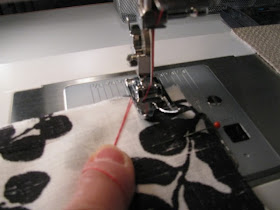Wednesday Tip of The Week
I always keep a spool of silk thread in my sewing box. Usually one in a bright color - bright yellow is my color of choice. It's my go-to thread for hand basting and it should be yours too. Many years ago as a college student learning to tailor clothing my instructor taught me the many virtues of using silk thread. Aside from using it as a beautiful top stitching thread or as a strong thread for piecing fine fabrics, like silk together, it is also the perfect choice whenever hand basting is required.
Silk thread works particularly well for hand basting for several reasons. First, because of its smooth and silky nature, the thread is a breeze to remove. It literally slips out of your fabric even through machine stitches.
Second, it will never leave a color residue on your fabric like an all purpose thread will sometimes do. OK, its not likely to happen frequently or is something you probably think will happen, but when it does and ruins your project, you will remember silk is best.
Next, and probably the most important reason I like using silk thread for basting, is it will not leave any press marks in your fabric like regular thread may do especially in luxury fabrics, such as silk or wools. Basting and pressing sort of go hand and hand when it comes to sewing, so be safe rather than sorry and use silk.
I do a lot of hand basting when I sew. You could say I am an over cautious sewer. Hand basting helps me prevent mistakes and ensures garment pieces are perfectly matched together. I always hand baste my hems in place rather than just pin them. Without the pins in the way I can press the hem in place without risking any press marks. And, the basting holds the hem securely in place for the final hem stitching.
By the way, I also regularly run my thread through beeswax. I do this whether I am using regular all purpose or silk thread. This strengthens the thread and prevents it from knotting up while I stitch.

















